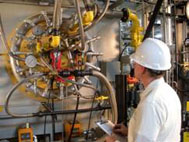Energy Efficiency through Cogeneration
 How a proven technology is revitalizing city infrastructure
How a proven technology is revitalizing city infrastructure
The three “Rs” of environmental stewardship—Reduce, Reuse, and Recycle—are the foundation of Combined Heat and Power (CHP), an efficient energy solution that’s garnering attention and interest throughout the United States. CHP is not http://new. The technology has been used around the globe for decades, but is currently seeing a resurgence as economic and environmental developments require better energy solutions.
Often referred to as cogeneration, CHP produces both power and thermal energy simultaneously—which can be used for heating, cooling, and processing. With conventional power generation, the majority of the fuel energy is released into the air or water as wasted thermal energy, and only 25% to 35% of the waste heat is converted into useful energy. When heat and power are produced separately, about 50% of the fuel consumed is converted into useful energy, and the remaining 50% becomes waste heat.
In contrast, by producing heat and power concurrently, CHP typically converts about 85% of the fuel to useful thermal energy. Unlike many other energy systems, CHP is clean, environmentally friendly, and Kyoto Protocol-compliant.
Case study: Exporting steam
The Boston and neighboring Cambridge, Massachusetts, district energy networks have increased the utilization of waste heat from a Cambridge-based energy plant that discharges millions of gallons of heated water into the Charles River every day. By piping the waste heat to Boston, commercial buildings, hospitals, and universities benefit from the addition, and the Charles River benefits from a decreased heat load. The notion of exporting steam became the proverbial “win-win.” Boston was able to the utilize steam created from waste heat, and the environmental impact on the Charles River was dramatically improved.
Today, approximately 50% of the steam used by the Boston district energy network is “green,” cogenerated steam that is imported from Cambridge. This steam has reduced the region’s fossil fuel consumption and greenhouse gas emissions. Plans are also underway to make use of even more waste heat by converting it into useful thermal energy, or “green steam,” and importing it into Boston—which will further reduce the amount of hot water discharge into the Charles River from the Cambridge power plant.
CHP plants
In addition to municipalities, hospitals, universities, industrial plants and other large-scale facilities located on campus environments are prime candidates for CHP plants. These plants can meet the critical energy requirements of multi-building campuses on a stand-alone basis, or they can produce energy for district energy networks in central business districts that serve a wide variety of buildings.
In Boston, a city rich with institutions that usually have a campus or district perspective, CHP—with a district energy distribution network—can provide desired energy and environmental benefits. For example, many Harvard-affiliated teaching hospitals in the Longwood Area, including Beth Israel Deaconess Medical Center, Brigham and Women’s Hospital, Children’s Hospital, and Dana-Farber Cancer Institute receive cogenerated steam, so cooling and power from the Medical Area Total Energy Plant (MATEP).
In Cambridge, a CHP plant is maintained and operated within the campus of a major biotechnology center located near the Massachusetts Institute of Technology (MIT). This center utilizes its own plant as the primary source of energy, while the Cambridge district energy network serves as its back-up source of thermal energy. The green network concept has also been growing with Boston’s high-rise residential and commercial buildings, and even the tanks that ring the New England Aquarium benefit from CHP. In fact, for two years in a row, the Boston network has been recognized by the International District Energy Association (IDEA) for adding and renewing the most buildings of any network in North America.
Investing in the energy infrastructure that serves communities ensures the highest level of reliability and efficiency, decreases the volume of fossil fuels consumed, and reduces the region’s carbon footprint. The combination of CHP and the district energy networks in downtown Boston, MATEP, and Cambridge has already resulted in annual carbon dioxide emissions reductions equivalent to 50,000 cars being removed the streets. Once additional steam is imported into Boston from Cambridge, the equivalent of 80,000 cars will be removed from the streets in terms of carbon dioxide emissions reductions. District energy and CHP are proven technologies that can produce material results, revitalizing cities and campuses.
Rowan Sanders is director of marketing and communications at Veolia Energy North America.
Veolia Energy North America
www.veoliaenergyna.com
Author: Rowan Sanders
Volume: September/October 2011











